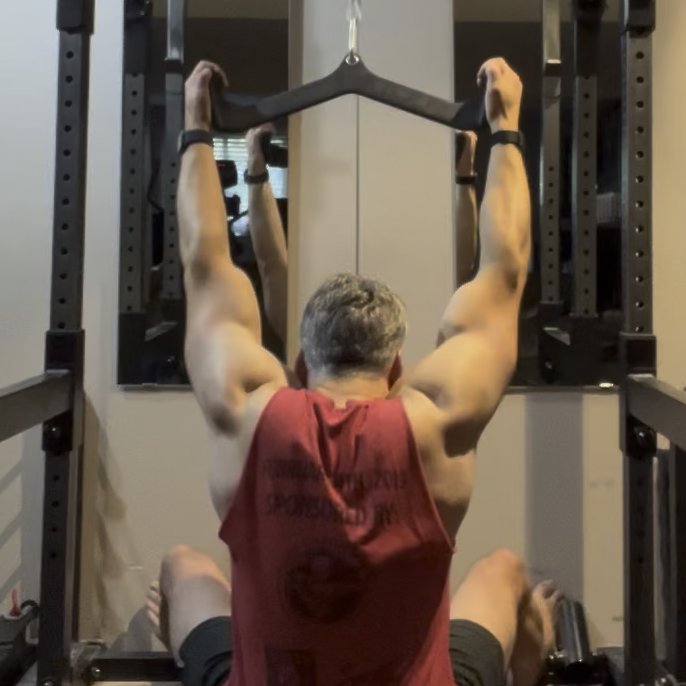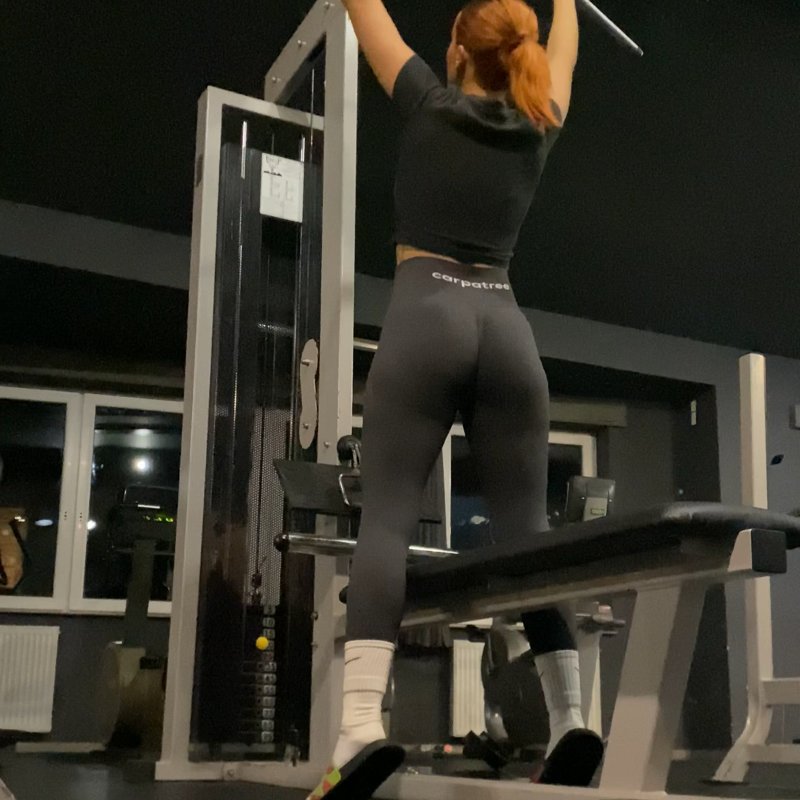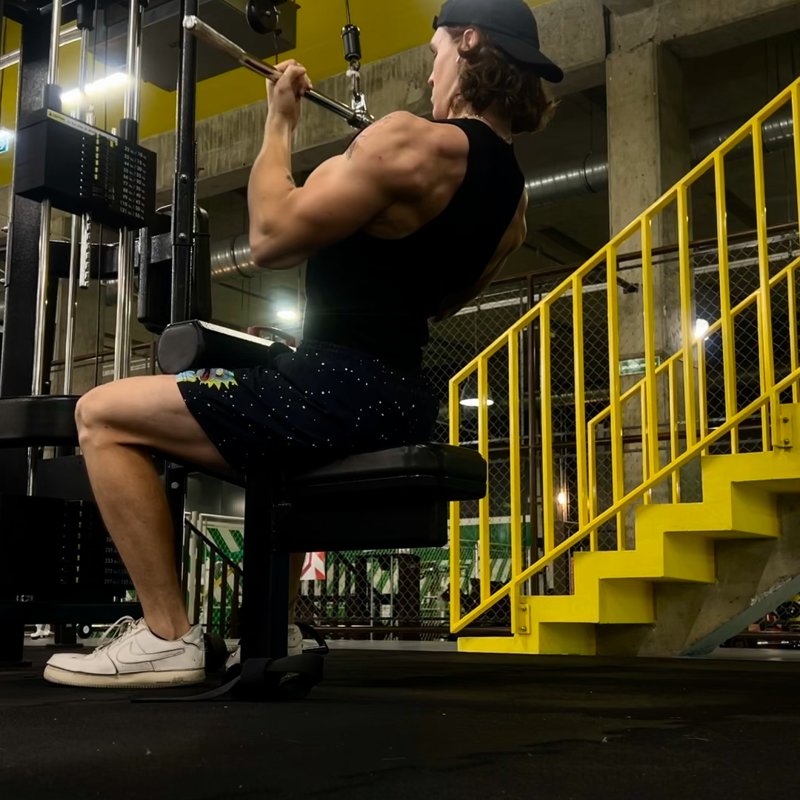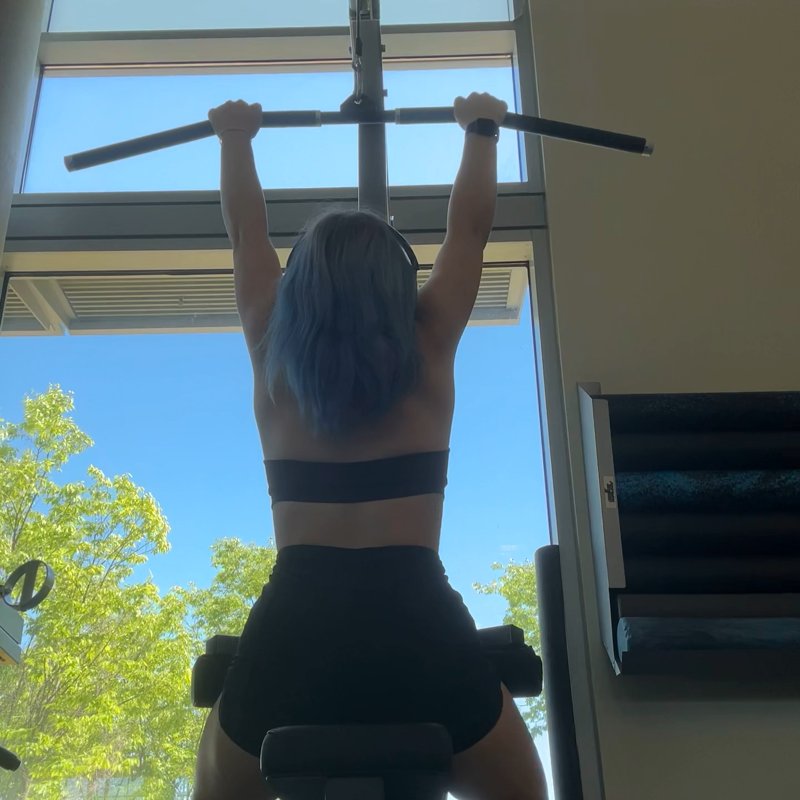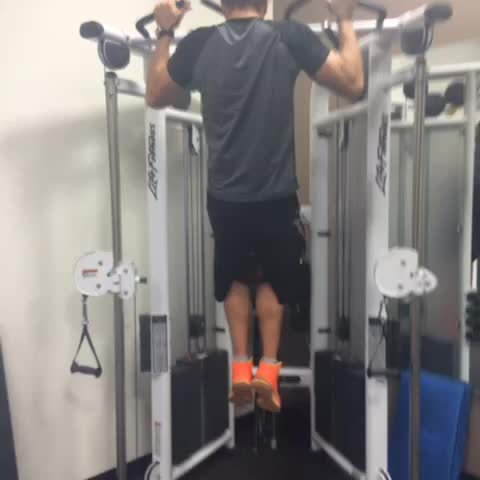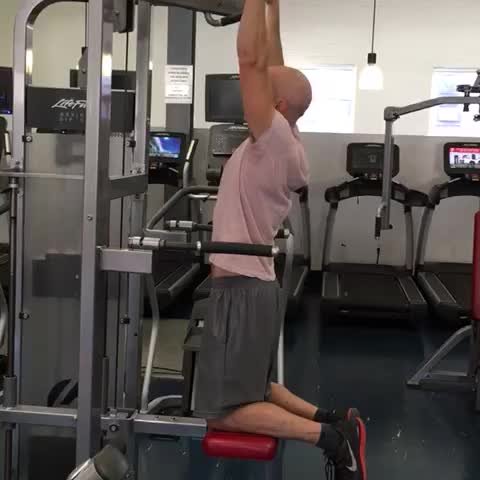Neutral Grip Lat Pulldown: The Ultimate Guide
The Neutral Grip Lat Pulldown is a vertical pulling exercise performed with palms facing each other, primarily targeting the latissimus dorsi while being particularly joint-friendly for the shoulders, elbows, and wrists.
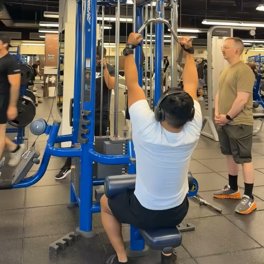
Quick Facts
Key Benefit
Lat development with reduced joint stress
Primary Muscles
Lats, Rhomboids
Secondary Muscles
Abdominals, Biceps, Brachialis, Forearms, Posterior Deltoids, Traps
Equipment
cable machine
Difficulty
Beginner
Type
Compound
In This Guide
Ready to master the Neutral Grip Lat Pulldown?
Track your progress, see improvements over time, and build strength consistently.
Download GravitusThe Neutral Grip Lat Pulldown is an excellent variation of the traditional lat pulldown that offers unique benefits for back development and joint health. This exercise primarily targets the latissimus dorsi—the large, wing-shaped muscles that give the back its width—while also engaging the rhomboids, rear deltoids, biceps, and core stabilizers. What distinguishes the neutral grip variation is the hand position, with palms facing each other rather than facing forward (pronated grip) or backward (supinated grip). This neutral or "parallel" grip provides several advantages, including a more natural wrist position, reduced stress on the elbows and shoulders, and potentially greater activation of certain portions of the lats. For many lifters, the neutral grip allows for a stronger mind-muscle connection with the back muscles, as it minimizes biceps dominance that can occur with underhand variations. The parallel hand position also typically enables a fuller range of motion and more complete contraction of the lats at the bottom position. Whether your goal is to build back width, improve posture, enhance pulling strength, or simply add a joint-friendly back exercise to your routine, the Neutral Grip Lat Pulldown delivers targeted stimulation in a comfortable, accessible format suitable for lifters of all experience levels.
Benefits of Neutral Grip Lat Pulldowns
The neutral grip variation offers several distinct advantages compared to other lat pulldown variations.
Joint-Friendly Hand Position
The palms-facing-each-other grip creates a more natural alignment for the wrists, elbows, and shoulders, potentially reducing stress on these joints.
Enhanced Lat Activation
The neutral grip often allows lifters to feel a stronger mind-muscle connection with the lats, minimizing over-reliance on the biceps during the pull.
Greater Range of Motion
Most neutral grip attachments facilitate a fuller stretch at the top and more complete contraction at the bottom compared to some other grip variations.
Balance Development
The symmetrical hand position tends to produce more balanced muscular development between the left and right sides of the back.
Carryover to Chinups
The movement pattern closely resembles neutral grip pull-ups/chinups, making it excellent for building strength for this bodyweight exercise.
Proper Form & Technique
Setup
- Attach a neutral grip handle (with palms-facing-each-other grip positions) to the high pulley of a lat pulldown machine.
- Adjust the knee pad to fit securely over your thighs when seated, preventing your body from lifting during the pulldown.
- Sit facing the machine with feet flat on the floor, approximately hip-width apart.
- Reach up and grasp the handles with palms facing each other at approximately shoulder width.
- Sit tall with chest up, shoulders down and back, and a slight arch in your lower back.
- Lean back slightly (about 10-15 degrees) from the hips to optimize the pulling angle.
- Look straight ahead or slightly upward with your chin tucked slightly to maintain neutral cervical spine alignment.
Movement
- Begin by taking a deep breath and engaging your core muscles.
- Initiate the movement by depressing your shoulder blades—think of pulling them down toward your back pockets.
- Pull the handles down by driving your elbows toward your sides while keeping your chest up.
- Focus on using your back muscles rather than your arms to move the weight.
- Maintain a slight lean throughout the movement, avoiding the tendency to rock backward and forward.
- Continue pulling until the handles reach approximately upper chest level, with elbows close to your sides.
- At the bottom position, squeeze your shoulder blades together briefly to maximize lat contraction.
- Exhale as you complete the contraction phase.
- Slowly return to the starting position with control, allowing your arms to extend fully and your lats to stretch.
- Inhale during this extension phase, preparing for the next repetition.
- Maintain tension in your lats throughout the movement, avoiding rest at the top position.
- Repeat for the prescribed number of repetitions, focusing on quality over quantity.
Key Form Tips
Lead with Elbows
Think about pulling with your elbows rather than your hands to maximize back engagement.
Shoulder Position
Keep shoulders down and away from your ears throughout the movement to optimize lat activation.
Core Engagement
Maintain tight core muscles to stabilize your torso and prevent excessive arching or swinging.
Full Range
Allow for complete extension at the top to stretch the lats and complete contraction at the bottom.
Control
Focus on smooth, controlled movement rather than using momentum or jerky motions.
Muscles Worked
Primary Muscles
- lats: The large, fan-shaped muscles on the sides of the back that are primarily responsible for the pulling motion and give the back its width.
- rhomboids: The muscles between the shoulder blades that retract the scapulae and are engaged during the squeezing portion of the movement.
- teres major: Often called the "little lat," this smaller muscle works alongside the latissimus dorsi during shoulder adduction and extension.
Secondary Muscles
- biceps: The front arm muscles that flex the elbow during the pulling motion, serving as important secondary movers.
- posterior deltoids: The posterior portion of the shoulder muscles that assist in the pulling movement and shoulder extension.
- traps: The middle and lower fibers assist in scapular retraction and depression during the pulldown movement.
- brachialis: Arm muscles that assist with elbow flexion during the pulling phase, with the neutral grip particularly engaging the brachioradialis.
- abdominals: The abdominals and obliques work isometrically to stabilize the torso throughout the exercise.
- forearms: The muscles of the forearm that maintain your grip on the handles throughout the movement.
Common Mistakes and How to Fix Them
Using Excessive Body Movement
Swinging or leaning back dramatically to move the weight reduces lat activation and increases injury risk. Keep your torso relatively stable with only a slight lean throughout the movement. If you find yourself needing to swing to complete repetitions, the weight is likely too heavy. Reduce the resistance to a level that allows for controlled movement without momentum. Focus on initiating the movement with your shoulder blades rather than by yanking with your arms or rocking backward. Consider having a training partner observe your form or film yourself to identify unwanted body movement.
Pulling to the Wrong Position
Pulling the handle to the upper abdomen or neck rather than the upper chest can reduce lat engagement and increase biceps dominance. Focus on pulling the handles to your upper chest with elbows driving down and slightly back. Visualize trying to touch your elbows to your sides rather than just moving the handles. Use a mirror if available to check that the handles reach approximately upper chest level at the bottom of the movement. The exact finishing position may vary slightly based on individual proportions, but for most people, upper chest level with elbows at sides represents optimal lat engagement.
Incomplete Range of Motion
Not reaching full extension at the top or complete contraction at the bottom limits development. Ensure you allow your arms to extend fully at the top position, feeling a stretch in your lats before initiating the next repetition. At the bottom, pull until you achieve a complete contraction with the handles at upper chest level and elbows at your sides. If maintaining proper form through the full range is challenging, consider temporarily reducing the weight until your strength develops throughout the entire motion. Quality of movement through a complete range will produce better results than using heavier weights with partial repetitions.
Excessive Wrist Movement
Bending the wrists during the exercise can reduce force transfer and potentially cause strain. Maintain neutral wrist alignment throughout the movement, with wrists in line with your forearms. The neutral grip naturally encourages proper wrist position, but still requires conscious attention, especially when fatigue sets in. If you notice wrist bending, focus on gripping the handles firmly while keeping your wrists straight. Consider using wrist wraps for additional support if this is a persistent issue.
Hunching Shoulders
Allowing shoulders to elevate toward the ears diminishes lat activation and can contribute to neck tension. Begin each repetition by consciously depressing your shoulder blades—think about pushing them down and back before initiating the pull. Maintain this depressed shoulder position throughout the entire set. Practice scapular depression exercises without weight to reinforce this pattern. Remember that the movement should be driven by your back muscles pulling your elbows down, not by your shoulders hunching or your arms doing all the work.
Exercise Variations
Grip Width Variations
-
Narrow Neutral Grip Pulldown
Using a closer grip to emphasize the lower lats and increase the range of motion for a more intense stretch at the top position.
-
Wide Neutral Grip Pulldown
Utilizing a wider-than-shoulder-width grip to place greater emphasis on the upper lats and outer portions of the back.
-

Alternating Neutral Grip Pulldown
Pulling with one arm at a time while maintaining a hold at the bottom with the other arm, increasing core stability demands and unilateral development.
Position Variations
-

Inclined Neutral Grip Pulldown
Increasing the backward lean to approximately 30 degrees to simulate the angle of a neutral grip row, offering a hybrid between vertical and horizontal pulling.
-

Standing Split Stance Pulldown
Performing the exercise in a half-kneeling or split stance position to increase core engagement and provide a different angle of pull.
-

Single-Arm Neutral Grip Pulldown
Executing the movement with one arm at a time to address potential muscle imbalances and increase anti-rotational core demands.
Technical Variations
-

Neutral Grip Pulldown with Pause
Adding a 2-3 second isometric hold at the point of maximum contraction to increase time under tension and enhance mind-muscle connection.
-

Eccentric-Focused Neutral Grip Pulldown
Emphasizing the negative portion with a 4-5 second controlled return to the starting position to increase muscle damage and growth stimulus.
-

Neutral Grip Pulldown with Scapular Depression
Performing several scapular depressions (shoulder blade pulling down without bending the elbows) before beginning regular repetitions to pre-activate the lats.
Frequently Asked Questions
Neither grip is universally "better"—they each offer distinct advantages that make them complementary rather than competitive. The neutral grip typically allows for a more natural wrist and shoulder position, which many lifters find more comfortable, particularly those with existing shoulder or elbow concerns. This grip often enables a stronger mind-muscle connection with the lats and may reduce biceps dominance during the pull. The pronated (overhand) grip tends to create slightly more upper lat and teres major activation and better mimics the movement pattern of regular pull-ups. It may also provide greater activation of the lower trapezius. For most trainees, incorporating both grip variations in a training program provides the most comprehensive development. You might rotate between grips across different training sessions or even within the same workout to target all portions of the back musculature. Your individual anatomy, injury history, and specific goals should guide your grip selection. If one variation causes discomfort or feels significantly weaker than the other, focus on the more comfortable variation while gradually introducing the other as mobility and strength improve.
Most people respond well to training each muscle group 2-3 times per week with sufficient recovery between sessions. For the Neutral Grip Lat Pulldown specifically, incorporating it 1-2 times weekly is typically optimal for most trainees. If following a body part split, you might perform this exercise on your designated back or pull day once per week. With an upper/lower split, it could be included in one of your two weekly upper body sessions. For full-body training, it might appear in 1-2 of your 3-4 weekly workouts. Consider your overall back training volume—the Neutral Grip Lat Pulldown is just one component of complete back development that should be balanced with horizontal pulling (rows), direct rear deltoid work, and potentially other grip variations of vertical pulling. More advanced lifters might benefit from undulating approaches where the exercise appears twice weekly but with different loading parameters each session (e.g., heavier/lower reps in one session, lighter/higher reps in another). Monitor recovery between sessions—if back performance decreases or joint discomfort develops, you may need more recovery time or reduced volume. A good starting point is performing 3-4 working sets 1-2 times weekly, adjusting based on your individual response and recovery capacity.
The appropriate weight for Neutral Grip Lat Pulldowns depends on your current strength level, training experience, and specific goals. Rather than focusing on a particular number, select a weight that allows you to maintain proper form while challenging your back muscles in your target repetition range. For muscle building (hypertrophy), most trainees find success in the 8-12 repetition range. This typically means using a weight that causes significant fatigue in the final few repetitions while still maintaining strict form. For more strength-oriented goals, you might work in the 6-8 repetition range with heavier weights. Beginners should start conservatively—often with 50-60% of their bodyweight—focusing first on mastering the movement pattern before adding substantial load. Proper form indicators include: (1) the ability to initiate the movement by depressing the shoulder blades rather than yanking with the arms, (2) maintaining a relatively stable torso without excessive leaning or swinging, (3) achieving full range of motion both at the stretched position and contracted position, and (4) feeling the work primarily in your lats rather than just your arms. Whatever weight you choose, implement progressive overload by gradually increasing resistance over time, either by adding weight or increasing repetitions, to continue stimulating muscle development.
Neutral grip lat pulldowns can certainly serve as an effective substitute for pull-ups in your training routine, especially in specific circumstances. They're particularly valuable if you: (1) lack the strength to perform proper pull-ups with good form, (2) are working around a shoulder, elbow, or wrist injury that makes pull-ups uncomfortable, (3) need a more controlled environment to focus on mind-muscle connection, or (4) want to precisely control the resistance for specific rep ranges. The pulldown mimics the movement pattern of neutral grip pull-ups while allowing for adjustable resistance and removing the body weight variable. However, there are some unique benefits to pull-ups that pulldowns don't perfectly replicate: (1) pull-ups require greater core stabilization and full-body coordination, (2) they engage additional stabilizer muscles due to the freely moving body, and (3) they tend to have greater carryover to athletic movements and real-world strength. For optimal development, consider using pulldowns as either a progression toward pull-ups, a supplement to pull-ups, or a temporary replacement during specific training phases. If your goal is to eventually perform pull-ups, include specific pull-up progression work alongside pulldowns. For many trainees, the ideal approach is to incorporate both exercises in their program, perhaps using pulldowns for higher-volume work and pull-ups for strength development.
Video Demonstrations

Log in to watch video demonstrations
Login to Watch3 video demonstrations available
Find more video demonstrations in the Gravitus app
Tips from the Community
-

Yh had the same problem, just need to arch your lats more horizontal
Track your progress with Gravitus
Download Gravitus to log your workouts, track your progress, and join a community of fitness enthusiasts.

Helpful Resources
One Rep Max Calculator
Find your one rep max for any exercise without maximal testing. Essential for developing effective strength training programs.
Calculate 1RMWorkout Programs
Follow structured workout programs created by fitness professionals to maximize your strength and muscle gains.
View Programs